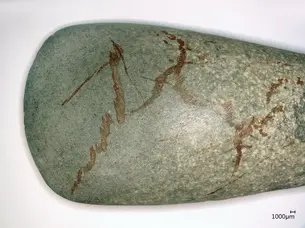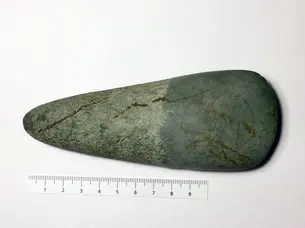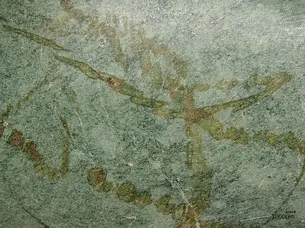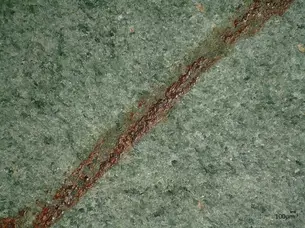Late Neolithic Stone Axe from Königsfeld/ Bamberg County
Content and aims
Around 5500 BC, one of the most significant changes in human history occurred in Central Europe: the shift from a nomadic hunter-gatherer community to the sedentary life of arable farmers and cattle breeders. The cultivation of edible plants, the domestication of wild animals and the founding of the first permanent settlements completely changed the previous way of life. Regular harvests caused the population to increase, which also fundamentally changed the social and societal structures. Until today, the exact processes of this "Neolithic Revolution" are not clarified in detail and are the starting point of various researches. In recent years, various Neolithic settlements have been investigated in the region and on the Northern Franconian Alb. Archaeological excavations of the University of Bamberg found, among other things, near Königsfeld in Upper Franconia, the oldest ditch in a low mountain range location in all of Europe to date, which enclosed a settlement of the Linear Pottery culture as a fortificatory structure in the 50th century BC.
In 2016, a volunteer collector found a Late Neolithic axe (ca. 4200-3500 BC) in a freshly plowed field, which was promptly handed over to the Chair of Prehistoric and Early Historic Archaeology in Bamberg for examination. Although this axe comes from the area of the early Neolithic settlement, it is clearly younger than this settlement and is probably connected with a ritual deposit. An associated settlement of the so-called Michelsberg Culture is probably located on the nearby Kirchberg near Königsfeld, since readings of the same period are known from there. One striking feature of the find is that it resembles the so-called jadeite axes, the raw material of which originates from the vicinity of Monte Viso (northern Italy). These prestigious objects were traded for several centuries throughout Europe to Scandinavia. Closer examination of the compact support material by fiber microscope, scanning electron microscopy, and infrared spectroscopy (FT-IR) actually suggest a sodium aluminum silicate consistent with jadeite. Elevated levels of calcium and magnesium could indicate association of the jadeite with nephrite, which would suggest another deposit.
Whether the axe actually originates from Piedmont could not be clarified beyond doubt and requires further, especially geological investigations. A further, far greater conspicuous feature of the stone object, however, are the brownish-red lines occurring on both sides, which could represent a kind of painting. This finding would make the axe an absolute unique specimen. Therefore, in order to clarify the red traces, investigations were carried out at the KDWT, which focused on the material composition of the colored application.
Methodology
High-resolution microscope images (Keyence/ VHX 5000) showed that this "painting", which can be interpreted as lines, dashes and spots, is a paint applied in several layers. The application is present as a paint agglomerate in the areas still preserved. Indications that it might be inorganic iron pigments in a binder matrix could be deduced from the high content of fine-grained iron compounds, which "bleed" rust-brown in marginal areas and have discolored the rock interface below the drawing reddish-brown. Also the secondarily formed shiny crusts, which are partly found on the surface of the somewhat thicker lines, speak for mobilized iron phases. The "bleeding" and crust formation are related to the small grain size of the iron pigments. Due to moisture and diffusion, these particles, which are only 0.002 to 0.063 mm in size, migrate and deposit on surfaces in thin but intensely colored layers. Scanning electron microscopic analyses (SEM: Philips/ XL40; EDS: Bruker/ AXS X-Flash Detector 5010) confirmed the assumption. It was also found that the iron pigments are bound in an organic matrix. This is inhomogeneous and interspersed with micropores and foreign particles, which resemble cell tissue.
Measurements showed, besides the rock-typical elements like Na, Mg, Al and Si, mainly carbon compounds, in which Ca and Mg, Na and K, S, Cl and Fe as well as P are clearly enriched. To formulate a first thesis on the origin of the organic matrix, the comparison with the composition of blood plasma was used, from which parallels can be derived. According to this, the binder of the red paint could have been a suspension of cellular components, plasma proteins, fatty acids and the electrolytes and hemoprotein found in blood. This would also explain the inhomogeneity of the matrix. The fact that these components can be found despite the great age of the axe and, above all, the long period of soil storage can be explained, on the one hand, by the protective effect of the iron crusts on the lines and, on the other hand, by the secondary silicification of the layer due to the incorporation of microcrystalline SiO2 as a result of soil storage. FT-IR measurements (PerkinElmer/Frontier/Spotlight 400) also confirmed the finding of an organic binder and the presence of inorganic iron pigments. The latter are a mixture of iron(III) oxide (hematite) and umber species. The organic binder of the matrix can be addressed IR spectroscopically as degenerated proteins with fatty acids (lipids). For the interpretation of the micropores rich structure, the boiling of the iron pigments in a decoction of blood with residues of fatty acid containing tissue is conceivable, which could result in a mass, which was applied as a pasty "paint" on the jadeite axe was applied.
For a preliminary clarification of the findings, the axe from Königsfeld was compared with another jadeite axe from the holdings of the Historical Society of Bayreuth, which was found in 1997 near Prüllsbirkig near Pottenstein. This jadeite axe can also be dated to the Late Neolithic. The substantial similarities are amazing. This was confirmed, among other things, by analyses of the hatchets with ICP-MS measurements, which were carried out at the TU Munich at the Center for Building Materials and Materials Testing in a non-destructive manner. Now it is the task of Prehistoric and Early Historic Archaeology to discuss the paint application in historical context with other Neolithic finds and to shed more light on the extraordinary Neolithic settlements and finds of northern Bavaria in further projects.




